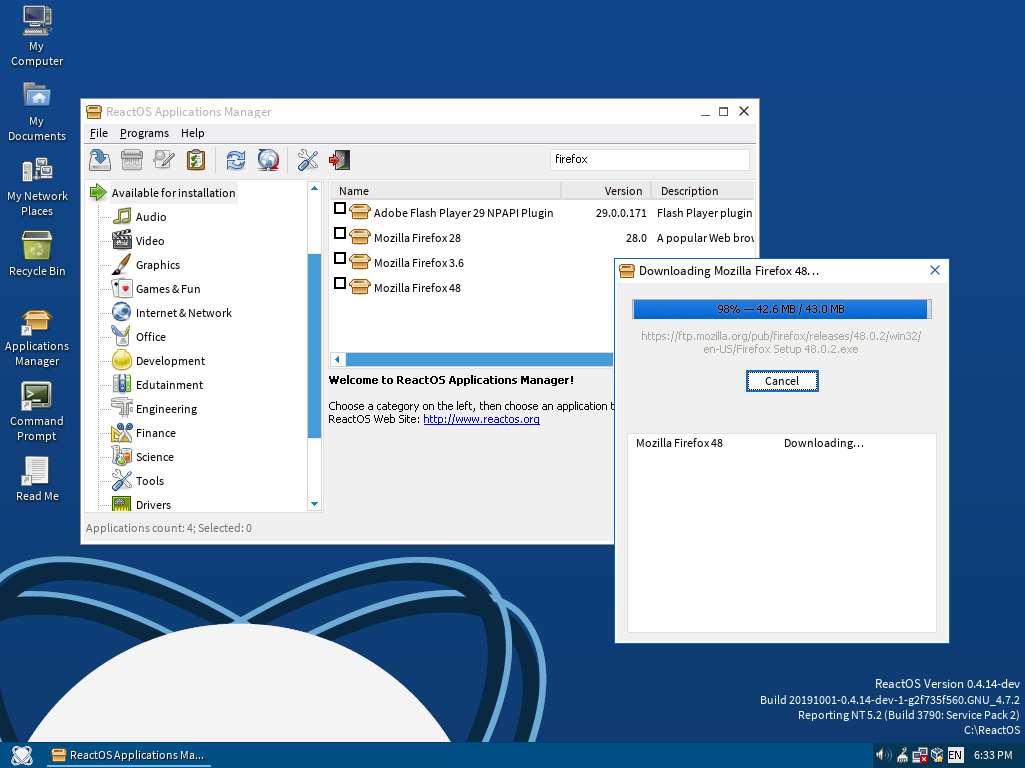
Download ReactOS Download Free – 0.4.14

Download Free ReactOS Download Free – 0.4.14
ReactOS is an independently developed open source operating system. ReactOS is not a Linux-based system and does not share any of the UNIX architecture. ReactOS has an interface that mimics the older Windows operating systems.

Characteristics
- ReactOS is capable of running Windows software
- ReactOS is capable of running Windows drivers
- ReactOS looks like Windows
- ReactOS is free and open source
What is ReactOS?
ReactOS is a free and open source operating system written from scratch. The design is based on Windows in the same way that Linux is based on Unix, but ReactOS is not Linux. ReactOS looks and feels like Windows, is capable of running Windows software and Windows drivers, and is familiar to Windows users.
Is ReactOS free?
Free and open source. Free as in “you can download it for free”, and open source.. meaning you can see how ReactOS is coded, you can modify it, you can provide patches for any bugs you find, and even more: You can create your own ReactOS versions! You use open source software daily if you use Firefox, LibreOffice, OpenOffice, GNU-Linux distributions among the zillions of open source projects out there. The Open Source projects, like ReactOS, are driven for and by the community, so being active in translating, donating, or coding is a way to help ReactOS grow forward.
What are the differences between Windows and ReactOS?
There are mainly two. First, ReactOS is open source. Second, ReactOS is free. Also, Windows (especially the newer versions) is known to monitor all your activity by default. So if you’re concerned about your privacy or just don’t want to share any personal information, we promise (and you can check our source code) that we won’t track any of your data.
Can I install ReactOS and run Windows compatible software on it?
Probably yes. However, we recommend checking first if your favorite app runs in ReactOS. ReactOS is still an ongoing project, and not all apps and drivers run perfectly on it. The best way to check compatibility is to install ReactOS inside a virtual machine (a step-by-step and video guide can be found here) and try your own needs. There are tons of software out there, and as you might imagine, it’s impossible to track them all.

What is new
Hello ReactOS followers and enthusiasts! It has been quite some time since we published the 101st newsletter and so far no more updates have been posted since then. While the ReactOS Twitter account makes announcements, posts about working applications, and such from time to time, much of what’s going on with the project as a whole goes unmentioned. Most of what we will talk about is the current situation with releases and general ReactOS development.
Why is it taking so long to release a new version of ReactOS? Are you dead?
The latest release of ReactOS is 0.4.14, published on December 16, 2021. This release alone took a year to develop. Back then, ReactOS followed a 3-month cadence, releasing a new version every three months. But since 2021, ReactOS is still at 0.4.14. Are you dead?
The answer is absolutely no, the way we handle releases has changed. Back in the day, ReactOS releases were made for the sake of quantity rather than quality. Each new release after 3 months was similar to the previous one, except for a small number of additional features and bug fixes. But overall, the net gap between the releases was not that big. For some time now we have introduced a rule that for a new version to reach “Release” status, it must have a reasonably low number of regressions (no more than 20) and its stability must not be adversely affected by the introduction of new features or code changes made during development.
In other words, the ReactOS project now focuses on providing quality releases, which rules out 3-month release frequency. The previous approach was not possible for a development team of our size anyway.
It is expected that it will take longer for a new release to be published, although these releases will now be much more comprehensive, with a much larger number of improvements. If you’re impatient to test the latest changes and features, you can always try the nightly builds (aka experimental builds).
Development status
During the last year and into early 2023, both the ReactOS developers and contributors are working on many parts of the project, with the most focused area being the core. Other non-core areas are the applications, specifically our Paint and Notepad programs, the Input Method Editor (IME) as well as other things like the ReactOS test infrastructure.
ReactOS x64 port status
The x64 port of ReactOS, while still in its infancy, has steadily improved in terms of stability. Back then, ReactOS could barely boot, and if it ever did, it usually resulted in an instant crash or a BSoD just doing simple tasks. With the help of Timo Kreuzer (tkreuzer), the x64 port has reached a somewhat tolerable state where ReactOS can now work without any major problems.
Although issues still remain and compatibility is worse than the x86 version, more applications and even hardware drivers have started to work. Note that the x64 port will not currently run ANY x86 applications due to the lack of WoW64.
WHS test fix
The WHS test bot (acronym for Windows Home Server) is a bot running Windows Server 2003 where it runs the entire ReactOS test suite infrastructure, ensuring that each test case passes the test results in a Windows environment. This helps you understand how Windows behaves when certain test inputs are given to it. The WHS test case infrastructure was known to fail a lot due to tests failing, or even crashing. In January 2023 during the hackfest, Timo Kreuzer (tkreuzer), Mark Jansen (learn_more) and Thomas Faber (ThFabba) worked together to fix some of the test cases. Thanks to their efforts, WHS can now pass all the tests.
Improvements in paint and notepad
Thanks to Katayama Hirofumi MZ, both Paint and Notepad have received quality of life improvements, various fixes and such. In particular, he fixed some flickering issues on Paint when he resized the program’s window and implemented the “text tool” feature. Additionally, he improved the performance of Notepad, implemented the “Now Printing” dialog, and made some miscellaneous fixes.
Security subsystem improvements
George BiÈoc (GeoB99) has been gradually improving the security subsystem (Se) of the kernel with new things as well as bug fixes, especially improving the security access controls and access tokens.
An access check is an action performed by the kernel to verify that an object can be accessed by a request. If the requester does not have the proper privileges to access an object, or the object itself prevents others from taking certain actions required by an access control list (ACL), access is denied. There was a hack in SepAccessCheck where access was granted to anyone, regardless of the security restrictions imposed by security descriptors. This can cause bad actors to tamper and play with objects.
Thanks to his work, the hack in SepAccessCheck has been removed and security checks are now operational and the kernel can prevent any unauthorized access by whoever tries to access an object with inappropriate access rights. His future plan for the security subsystem is to implement security auditing of all objects and various improvements where necessary.
Registry improvements
For ReactOS to reach the beta phase, it must solve two major milestones – stability and corruption. Typically, corruptions in ReactOS can manifest in the form of file system and registry corruptions. While file system corruption can be prevented by choosing a more modern file system like BtrFS, which is what we currently support, registry corruption itself is a death sentence as ReactOS currently does not implement any self-healing mechanisms to recover the system from corrupt registry data. . As a result, the user is forced to do a clean reinstall of the system. In the worst case scenario, the system would still boot but get stuck in the login dialog (also called the “Ctrl+Alt+Del” dialog) because the user profile has been corrupted or is missing. The latter usually happens after ReactOS is forcefully shut down after a clean install.
George BiÈoc is currently working on improving the registry by implementing the necessary self-healing mechanisms for the registry and CmCheckRegistry, a basic function that validates the registry for any corrupted parts of the registry and takes appropriate action to recover a registry cube from such corrupt parts. While his work is currently ongoing (#4571), he has so far received some positive results from testers. A small part of his work has been merged, fixing ReactOS registry flushing that hasn’t worked for almost a decade! This fix also solves the issue of the missing user profile due to hard system shutdown, and as such you should no longer expect to see the infamous “Ctrl+Alt+Del” dialog as often as before.
Additionally, he is working on the registry cache implementation (#5088), as ReactOS does not synchronize the cached information properly, leading to inconsistent results.
Currently, most of this work is still being maintained because it makes the bootloader size larger than it should be, preventing the AMD64 build of ReactOS from booting.
IME project
The Input Method Editor (or IME) is a component that facilitates the entry of characters that were not originally present on the input devices using a sequence of characters. The IME in ReactOS has mostly been a stub, but luckily Katayama Hirofumi MZ has been working a lot on it. This greatly helps with CJK support, as well as allowing the installation of custom IMEs for different locations. Katayama wrote an article about his work, the Japanese part of it was written using MZ-IME in ReactOS, here is the English part of it:
Seven months have passed since the last report, and I’d like to explain the current status of Japanese input in ReactOS. We have confirmed that Japanese ReactOS recognizes and can actually use MZ-IME Japanese input, a home-made test IME.
After the IMM32 implementation was almost complete, the remaining problem was the implementation on the USER32 side, where the standard procedure and handling of the standard IME window and EDIT control had not yet been written. Standard procedure required handling multiple IME messages. The default IME window is an invisible window that is important in IME messages; The EDIT control is a so-called text box that required proper handling of certain IME messages. When IME message handling was implemented, the IME composition string window and candidate window were displayed correctly.
Note that Japanese input for Command Prompt and Rich Edit Control is not yet available. Several bugs and instabilities remain. Please note that the ReactOS IMM is currently developed for older systems and does not support the newer TSF-compatible IMEs. Defects and issues can be reported at https://github.com/katahiromz/ImeStudy/issues.
Other highlights
- Dmitry Borisov (disean) fixed a BSoD caused by a shutdown with the Windows Server 2003 IDE driver stack.



